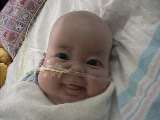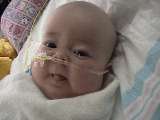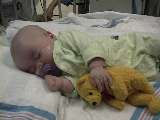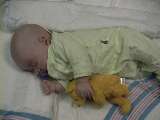![]()
Diary February 2002
Feb 4 2002 News: The hits just keep on coming. Saffy has been through the ringer and her ordeal isn't over yet. The pathology analysis of the tumors in her excised liver revealed not only the expected benign infantile hemangioendothelioma (IHE) but also the malignant form of the disease, angiosarcoma (also called hemangiosarcoma). We have repeatedly stated how rare IHE is, but hepatic angiosarcoma is even more uncommon. Typically only seen in older people who have been exposed to carcinogens like arsenic for a couple decades, fewer than 30 cases have ever been reported in children. The rarity of the condition has precluded the development of an effective treatment. To quote a recent medical text, "The course and prognosis of this disease are dismal; and usually lead to a fatal outcome."
The bright side of this bad news is that there is no evidence that the tumors have spread beyond Saffy's liver. Previous CT scans detected no other instances of IHE (which is radiographicly indistinguishable from angiosarcoma), and the transplant surgeons did not detect any invasion of other organs during the operation. She does have six cutaneous hemangiomas, but they have not grown in months and are, therefore, most likely benign. However, angiosarcoma is a highly malignant vascular tumor; and, while we hope it was totally removed during her liver transplant, recurrence is not uncommon. But, once again, there have only been a handful of reported cases, so it's impossible to draw conclusions based on the minuscule sample size.
We are discussing treatment options with Saffy's doctors. In a recent report, one child with hepatic angiosarcoma was successfully treated with complete surgical resection and aggressive chemotherapy (for 18 months). Unfortunately, the liver detoxifies chemotherapy, and Saffy's fragile new liver makes chemo a more risky proposition. At this point, the decision may be to do nothing but to closely watch for recurrence--which will be a necessity for years.
In other news, Saffy continues to experience difficulty in breathing without the assistance of a ventilator. On Friday, another attempt to wean her failed due to the collapse of her left lung. She was extubated yesterday for the first time in five weeks but was then soon reintubated. Hopefully she will improve quickly, but it could take several more attempts and a few more weeks before Saffy is able to breathe on her own. She is scheduled for a fluoroscopy to detect if her diaphragm is damaged.
Some good news is that Saffy's new liver is doing well. Her LFTs continue to improve and talk of biopsy to detect rejection has stopped for the moment. Elevated white cell counts and a mild fever led to concerns of infection, but so far all cultures have been negative. Her central line IV was removed due to concerns of infection. She is already on her second peripheral IV; but, luckily, she is doing very well with feeding via NG tube and nearly all of her medications have been switched to digestive forms.
The best news of all is that even with all Saffy has been through, she has made small steps forward developmentally. Saffy was intubated at two months corrected age--for developmental targets, her two months prematurity are subtracted--and she was just beginning to hit some milestones. Even though she is still intubated and sedated, she has improved by making eye contact and following moving objects with her eyes. In the last few days, she even began to smile for the first time in response to praise and baby talk.
Those few smiles made all the hardships and angst melt away in an instant. Saffy is our treasure and joy, and we feel like the luckiest parents in the world to have her. We love you, Saffy.
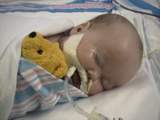 |
|
Saffy loves to be swaddled. So does Poopsie. |
Feb 6 2002 News: We continue to discuss treatment options with Saffy's doctors. Unfortunately, we have only found published cases of three children who survived hepatic angiosarcoma.
In order to combat the recurrence of this vascular tumor, Saffy will soon be switched to a different immunosuppressant drug that acts as an angiogenesis inhibitor, which prevents the development of new blood vessels. We are discussing chemotherapy; but, even so, her new liver needs more time before chemo could start. Due to the rarity of her condition, more pathological analyses of Saffy's old liver are being performed, and samples are also being sent to the Armed Forces Institute of Pathology for a second opinion.
Saffy is scheduled for another full-body CT scan next week to detect any evidence of the angiosarcoma spreading (most likely to her lungs or spleen) or recurring in her new liver. Dermatology is being consulted about the hemangiomas on Saffy's skin. All signs indicate that they are common benign tumors that will eventually go away on their own; but, due to the many unknowns with angiosarcoma, it may be wise to surgically remove them anyway.
Some good news is that yesterday's fluoroscopy revealed that Saffy's diaphragm is not damaged. Her doctors have started to wean her from the ventilator again and hope to attempt extubation again soon. Lung collapse continues to be a problem.
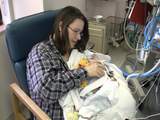 |
|
Jill holding Saffy (on BiPAP) |
Feb 11 2002 News: Saffy continues to have difficulty breathing without assistance. After the fluoroscopy confirmed that her diaphragm is working fine, her doctors began weaning her from the ventilator again. She was extubated for the second time on Thursday and put on a BiPAP (bi-level positive airway pressure) with nasal prongs. Even with assistance from the BiPAP, she continued to have difficulty and was reintubated the following day after her left lung collapsed again.
Saffy's doctors are not 100% sure of the cause of her continued respiratory difficulties. After her second failed extubation, they suspected that hemangiomas may have spread to her airways, but a CT scan on Friday did not see any tumors--but they are discussing a bronchoscopy to verify. While several possibilities were discussed, her doctors now believe that Saffy's enlarged heart is pressing against her left bronchus, and she is not strong enough to generate the pressure to keep her lung open. Another echocardiogram is scheduled to see if her heart has improved at all.
Since her doctors believe Saffy may require the ventilator for much longer than earlier hoped (perhaps several months), they want to perform a tracheostomy--insert a tube through her neck into her windpipe. We are certainly not overjoyed with this and are discussing the pros and cons.
While we are still waiting for the final pathological report about Saffy's removed liver, we continue to discuss angiosarcoma treatment options with her doctors. Further research of medical texts continues to produce grim news. We've located reports of three children and 14 adults with hepatic angiosarcoma treated with liver transplantation; but, unfortunately, none survived--the tumor usually recurred in the new liver. Of course, if it weren't for Saffy's new liver, she would already be dead.
The good news is that Saffy's new liver continues to perform well, and the CT scan last week found no evidence of tumor recurrence. We have high hopes that Saffy's name will be added to the very short list of survivors of this deadly disease.
Feb 13 2002 News: Saffy's doctors are attempting to wean her from the ventilator again with limited success. The bronchoscopy and tracheostomy--which her doctors want to perform in one trip to the operating room--was delayed until next week due to our indecision related to the trach. We would prefer to do without another incision and another scar (in a more visible place), but mainly we would prefer her to be off the ventilator altogether. Of course, if she's unable to breathe on her own, we may not have much choice. Her doctors are strongly recommending a trach and would have preferred to perform the operation yesterday.
Some good news is that the echocardiogram showed some improvement in heart function. The doctors didn't see a decrease in size though, which is what they now believe is contributing to Saffy's breathing problems.
Besides that, Saffy required another blood transfusion on Monday. On a positive note, she continues to show improvement with her hypothyroidism. She is still on a very low dose of Synthroid.
Feb 17 2002 News: Not much new to report. Saffy's new liver is doing well, yet she continues to have difficulty breathing without the assistance of a ventilator. We're still waiting for the final pathology report of her old liver. An angiosarcoma treatment plan--as well as a plan for her cutaneous hemangiomas--will not be established until the report is finalized.
Saffy spent her 100th day in the hospital yesterday--out of 178 days since her birth.
You can expect more frequent web updates in the future, since we just splurged on a new laptop, which will enable us to update our web site from anywhere--including the hospital where Alec and Jill typically spend night and day.
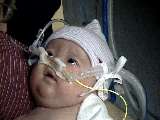 |
|
Saffy on BiPAP |
Feb 20 2002 News: Saffy was extubated again yesterday. So far she is doing relatively well off the ventilator and on the BiPAP. Her right lung has partially collapsed, but her doctors hope she will be able to open it up on her own (with the assistance of the BiPAP). When she was extubated for the first time over two weeks ago, she only lasted one hour off the ventilator. Her second attempt lasted 19 hours. This time, she has already passed 24 hours, so hopefully the third time's the charm.
Tomorrow will be one month since her liver transplant; and, in that respect, Saffy is doing well. The single round of chemotherapy she received over six weeks ago has finally caught up with her, and she is losing her hair (not that she had much to begin with). Saffy doesn't seem to mind though and is in good spirits. Her smiles continue to light up the room.
Feb 21 2002 News: Saffy continues to do well off the ventilator, and her doctors have already started to wean her from the BiPAP. So far so good. Thanks to all for the prayers and positive thoughts. They seem to be working!
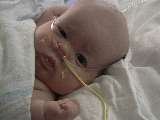 |
|
Saffy gets her oxygen |
Feb 22 2002 News: Saffy's breathing continues to improve off the ventilator. The BiPAP was removed this morning, and she is now breathing on her own--although she is getting supplemental oxygen.
The next step will be Saffy's return to bottle feeding. She currently gets formula and medicine through a nasal gastric (NG) tube. Unfortunately, she has been spitting up recently, so her return to normal feeding may take time.
However, such feeding difficulties will not keep Saffy in the PICU. Once her doctors are sure she is breathing without problems, she will be transferred to a step-down or regular hospital room and then eventually home. Her new liver is doing well, and nothing else is really keeping her in the hospital. Of course, we're still waiting for the final pathology report and then a treatment plan for the angiosarcoma. Before going home, she will undergo another CT scan to detect any metastasis of this aggressive cancer. Saffy's immediate prognosis is very encouraging, but the long term (months or years) effects of the angiosarcoma are still worrisome.
Saffy will be six months old tomorrow. At 10 pounds, she's still a small baby, but we hope she'll soon grow and catch up developmentally. She is now nearly bald. It could be the normal loss of her "starter" hair, but it happened so fast that we believe it's from the chemo she received in early January.
All in all, things are looking up. The roller coaster ride continues; but, right now, we're going uphill.
Feb 27 2002 News: Unfortunately, Saffy had some collapse of the upper lobe of her right lung today. After an x-ray, her doctors thought she would require the BiPAP again; but, by day's end, they thought it had improved. Hopefully she was able to open it on her own and will be able to keep it open. Even so, our preparation for Saffy's return home continues.
As far as the angiosarcoma, we have been waiting for the second opinion from the Armed Forces Institute of Pathology (AFIP) for three weeks, but we learned today that the samples have not even been sent yet--much to the surprise of some of Saffy's doctors. The samples will be sent tomorrow, but we just lost three weeks. I can't say we're happy with how long this is taking, but it probably won't make much of a difference in Saffy's treatment. It's much too soon after the transplant to start chemotherapy, but it would be nice to know for sure if Saffy's liver contained this deadly cancer.
There is also some confusion (probably on our part) about hemangioendothelioma type 2 and angiosarcoma. After reading some medical texts, it's our understanding that the former is a benign tumor and the latter is malignant, but we're being told they are the same thing. The pathologist at AFIP wrote many of the medical texts, so we're anxious to hear his analysis.
We continue to hope that the angiosarcoma was totally removed with Saffy's old liver, but we haven't yet found a published case where it hasn't reoccurred unless chemo was used after excision. Chemotherapy is especially dangerous due to Saffy's fragile new liver and the immunosuppressants she is taking, but it may be a risk we need to take since the prognosis of angiosarcoma is so dire. The other option is to closely watch for recurrence and treat it if it returns; but, at that point, it may be too late. Either way, Saffy will need at least a few months to get stronger before chemo can even be considered.
Saffy went for another CT scan yesterday (her eighth?) to see if the angiosarcoma has reoccurred in her new liver or spread elsewhere. Unfortunately, even after two hours, they were unable to get a clear image, because Saffy was moving too much. The CT scan will need to be repeated; and, hopefully, she can be calmed with additional sedatives. However, if the blurred images are due to her fast breathing, she may need to be intubated for the scan. After all the difficulty getting her off the ventilator, we don't like the idea of her being put back on it, but it may be necessary to get good images.
Saffy's adventure continues...
Feb 26 2002 News: Saffy continues to do well breathing on her own. She is still receiving supplemental oxygen, but it is slowly being weaned. She breathes very fast, which is puzzling to her doctors. It could be related to her heart problems.
Saffy continues to be fed via NG tube but is learning how to bottle feed again. It takes a lot of practice, and an occupational therapist is working with her. A physical therapist is helping her with gross motor skills. Saffy has not really grown since her transplant but will hopefully start to put on weight with the additional calories she is receiving.
Saffy was transferred to the PICU step-down unit yesterday--it's not quite a regular hospital room, but it's closer to going home. If she continues to improve at the same pace, she may go home as early as next week. At home, she will still need to be fed via NG tube (until she can master the bottle) and may require oxygen as well. Alec and Jill have already started to learn to insert the NG tube through Saffy's nose and down into her stomach. Saffy currently takes over a dozen medications (including immunosuppressants and antibiotics) and will continue to do so at home.
Hopefully we'll soon find the time to update Saffy's Photo Gallery with the many pictures we have taken since November; but, in the meantime, here are four more to hold you over.
![]() www.usticke.org
Saffy Liver Condition Home
www.usticke.org
Saffy Liver Condition Home
![]() Previous
Saffy Liver Condition Diary - Next Saffy
Liver Condition Diary
Previous
Saffy Liver Condition Diary - Next Saffy
Liver Condition Diary![]()
